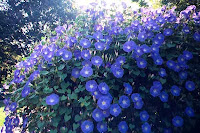
10. "Heavenly Blue" Morning Glory
Ipomoea tricolor (Active constituents: Ergoline alkaloids) This is a species of morning glory native to the New World tropics, and widely cultivated and naturalized elsewhere. The seeds have been used for centuries by many Mexican Native American cultures as an hallucinogen; they were known to the Aztecs as tlitliltzin, the Nahuatl word for “black.” Their traditional use by Mexican Native Americans was first discovered in 1941, brought to light in a report documenting use going back to Aztec times. It was reported in 1960 that the seeds of Ipomoea tricolor were used as sacraments by certain Zapotecs, sometimes in conjunction with the seeds of Rivea corymbosa, another species which has a similar chemical composition. Hallucinations are the predominant effect after ingesting morning glory seeds. Vivid visual and tactile hallucinations, as well as increased awareness of colors have been described.
This is a species of morning glory native to the New World tropics, and widely cultivated and naturalized elsewhere. The seeds have been used for centuries by many Mexican Native American cultures as an hallucinogen; they were known to the Aztecs as tlitliltzin, the Nahuatl word for “black.” Their traditional use by Mexican Native Americans was first discovered in 1941, brought to light in a report documenting use going back to Aztec times. It was reported in 1960 that the seeds of Ipomoea tricolor were used as sacraments by certain Zapotecs, sometimes in conjunction with the seeds of Rivea corymbosa, another species which has a similar chemical composition. Hallucinations are the predominant effect after ingesting morning glory seeds. Vivid visual and tactile hallucinations, as well as increased awareness of colors have been described.
 The quintessential image of an hallucinogenic "toadstool," with its red cap and white spots. More>>
The quintessential image of an hallucinogenic "toadstool," with its red cap and white spots. More>>































































































































































































































No comments:
Post a Comment